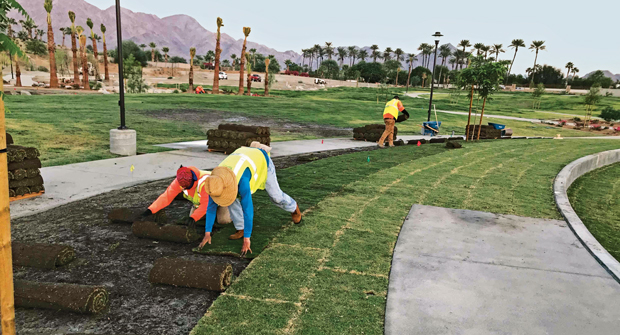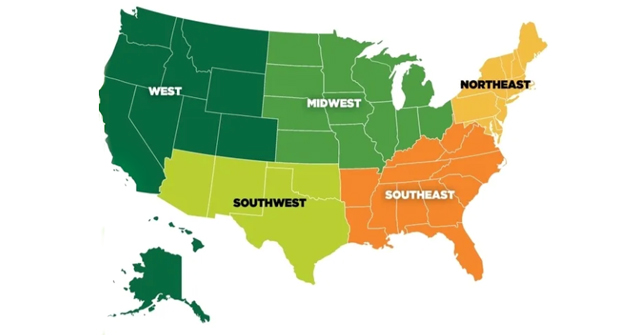Urban Habitat has two core values that it uses to compete: To have fun in what it does and create chaos in the market.
CEO Brett Brennan says Urban Habitat doesn’t have that multi-generational history or national outreach that some competitors can rely on, meaning that if they want to stand out in a tough market, they need to build their reputation in other ways.

“I’m just a guy who started 16 years ago,” Brennan says.
“I’m just in a different position, and our goal isn’t to out-compete others. We’re focused on enjoying what we do and delivering a high-quality product.”
The Palm Desert, Calif.-based company — No. 113 on the 2025 LM150 list — has spent its time growing from a simple landscaping company to one that now gets roughly 98 percent of its revenue in the government and public works sector, especially with the construction of community parks. Brennan says one of the largest areas of growth has been switching from subcontracting to being a prime contractor, now self-performing the majority of projects.
“In California, you have to self-perform 50 percent of these civil-type projects, and we have the equipment, the manpower, the knowledge and the resources to be able to do that, and a lot of people don’t,” Brennan says.
Having the employees and the ability to self-perform and capture more revenue per project has helped them shoot up 20 spaces from last year’s LM150 list, with a 44 percent change in revenue from 2023.
A friendly face
To help “disrupt the market,” Urban Habitat has worked to establish itself as a reliable, professional and knowledgeable company that cities and organizations can turn to with confidence. Especially when working with community projects, having a positive image and product is essential to their reputation.

“By the time we end the project and what we turn over, the community loves what we do,” Brennan says. “We just opened up a park (recently). When they cut the ribbon, 200 kids ran out to go play on the playground. People were sitting under these trees reading books … They love it, and that’s what keeps this organization going.”
Outside of landscaping and construction, Urban Habitat makes the effort to participate in the community as well, offering a friendly face where they can.
“We participate in all city events — cancer walks, whatever we can sponsor, try to give back to the community. We have a monarch butterfly garden as part of our parking lot, and we try to immerse ourselves in good things for our brand,” Brennan says.
And this kind of branding has helped Urban Habitat stand out in the market despite its relatively young and local status. After being founded in 2009, Brennan says the company has worked to create a strategy that is low-key, letting their work and professionalism speak for itself.
“Our trucks feature understated branding, without our phone numbers. All our equipment is well-maintained and clean,” he says. “Our brand is good; our brand is clean. What we do follows those guidelines, and I think all that makes us very, very different from our peers and our competitors that we deal with here in Southern California.”
Golden (State) opportunities
As many in the landscaping industry know, operating in California can be “challenging,” as Brennan describes it, all thanks to the state’s heavy regulations, weather conditions and other restrictions. Brennan says it’s even more regulated when you get into public works and funding like Urban Habitat does.
Despite this, for Brennan and Urban Habitat, there can also be some great opportunities that come from the Golden State if you play your cards right. For example, having a deep knowledge of a specific city, government and state processes impacting a project can help them either secure a contract or finish a job with fewer hiccups.
On top of that, Brennan says that contractors in California are larger per capita than those on the East Coast. And when working with public and city parks, there’s a lot of government funding being pumped into that sector.
“There’s strong funding in place currently. The pandemic brought significant investment into parks and green spaces, which contributed to our recent growth, and so that was a big push in our last couple of years,” Brennan says.
Brennan calls the market they’re in “unique,” and with how well they’ve grown into it, Urban Habitat found itself at No. 6 on the LM150’s top 25 revenue-generating firms in the government sector — up four places from last year.
“We’re in a unique market share,” Brennan says. “I mean, we’re probably getting higher on that list. I would say before long, we’ll probably be No. 1 (on the government sector list) because this is what we do.”
California culture
Despite the rapid growth, Brennan still says he’s learning how to be a CEO, and his background in the field still creeps into his routine. One thing he’s realized, however, is how important company culture is when trying to build a reputable business and retain top employees.
“(Back then) I didn’t know culture was important, to where now, I know it’s one of the most important things, and you can’t have culture as a small company,” Brennan says. “You don’t have the resources to do it. You’re just hiring people to fill positions to get the job done, but after you become more established … that’s where culture becomes very important in your organization to retain employees.”
Brennan says the company has invested heavily in creating a fun, professional culture where people want to come to work. Self-development, for example, is highly encouraged, and Urban Habitat not only offers professional development classes to employees, but it pays for them to go to classes as well.
“It’s taken a while, and we have a good group of people, and I think that once that machine gets going, it operates and runs on its own,” Brennan says. “It attracts other good people, and it attracts fun things around here.”
Fun is also a key component of cultural growth. The company has a Newfoundland dog that comes to work every day with doggy doors into each room. Urban Habitat takes trips to ribbon-cutting events at the parks they work on and has monthly meetings with lunch provided to discuss work and personal topics, keeping everyone connected and working together.
Looking ahead
While Brennan says it might be time to pump the brakes and refine some internal processes, it likely won’t stop Urban Habitat, and the company projects an even larger growth in revenue next year.
Regardless, Brennan says the goal for the next year is to thoroughly clean up their internal systems and processes to become more efficient in the office and out in the field. Software integration is another goal that they’ve been tackling recently.
But, like all hurdles they’ve faced so far, Brennan says Urban Habitat will work through them with the same efficiency and professionalism the company is now known for.
“We started in the recession here in California. Sixteen years ago, we had nothing to lose. We couldn’t go backward, so we just constantly moved forward, and we found a way to make it work,” he says. “And when it didn’t work, we stood back, we made a decision, we punted again and moved forward.”
Editor’s Note: The 2025 LM150 list is sponsored by Aspire Software, John Deere and Weathermatic.
Read more LM150:


